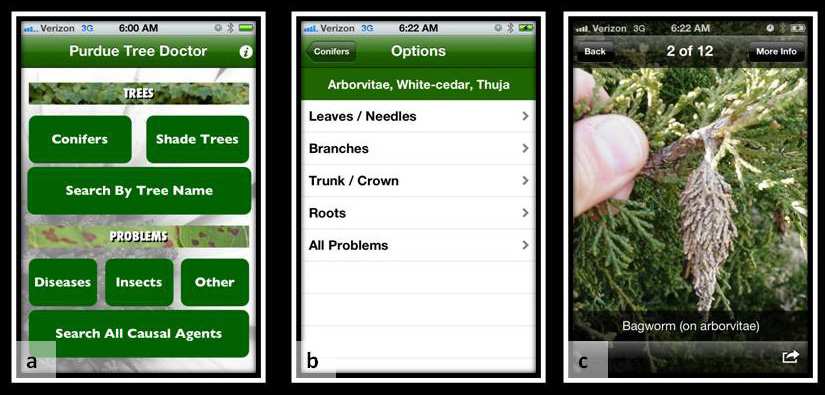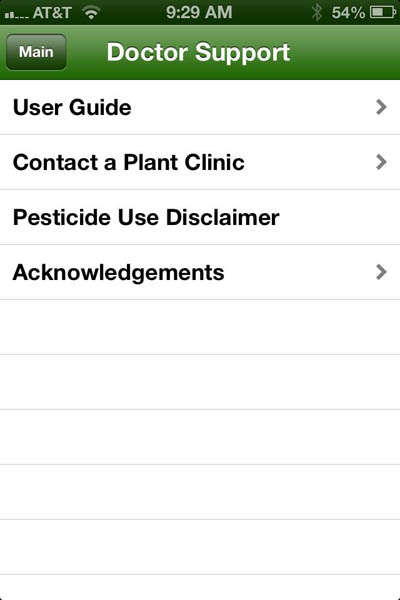 |
April 2013
|
April 2013 // Volume 51 // Number 2 // Tools of the Trade // v51-2tt3
Caught with Your Plants Down? There's an App for That!
Abstract
With or without pesticides, effective management of pests of trees in urban landscapes depends upon an accurate diagnosis. We describe how the Purdue Tree Doctor I-phone app was developed for use by homeowners and landscape professionals to diagnose tree problems and identify solutions. We then discuss how this resident smartphone app can be used in users' moment of learning need to provide diagnostic and management solutions to plant health problems.
Introduction
Consumer horticulture is one of the largest, yet underserved of commodity groups: 71% of households in the United States participate in some form of gardening (National Gardening Association, 2008), translating into approximately 80+ million homeowners, compared to fewer than one million farmers. Homeowners used 136 million pounds of pesticides (active ingredient weight) in 1997 (Grube, Donaldson, Kiely, & Wu 2007). Repeated surveys of homeowner pesticide use and pest abundance in urban landscapes suggest that many of these applications could be avoided through adoption of alternative management practices within an Integrated Pest Management (IPM) framework (Church, Buhler, Bradley, & Stinner, 2012). Moreover, when trained in a meaningful way, homeowners are capable of dramatic and sustained reductions in pesticide use (Sadof, O'Neil, Heraux, & Wiedenmann, 2004).
Homeowners typically apply higher rates of chemical inputs per hectare than their agricultural counterparts (Robbins & Birkenholtz, 2003). The majority of homeowners (56%) purchased these pesticides from home/garden centers and used these outlets as information for pest management recommendations. Retail store employees were found to rely upon the Ortho Problem Solver and available product labels as the primary references when making a pesticide recommendations; only a small percentage of respondents used Extension or USDA publications as references (Cecil & Czapar, 2001). Selecting the correct product was one of the five most frequent pesticide information requests received by Extension educators from homeowners (Church, Buhler, Bradley, & Stinner, 2012).
The first step toward resolving plant health problems in any management scenario is the proper diagnosis of its cause. 81% of 3,842 Extension Master Gardeners indicated a need for more training in identifying diseases, and 65% said they needed more training in identifying insects (Meyer et al., 2012). Thus, the need for tools for diagnosis and science-based, neutral party recommendations that could protect plant health with fewer pesticide inputs is obvious.
Why an App?
Today, nearly half of all Americans own some type of smartphone, and the numbers are increasing yearly (Rainie, 2012). Although most smart phone ownership (64%) is among 18 to 49 year olds (59-66%), a substantial proportion of smart phone owners are between 50 and 64. Our goal in developing the Purdue Tree Doctor app is to increase the adoption of IPM practices in urban homes and landscapes by improving the ability of the app user to diagnose common problems and obtain IPM-based solutions. Unlike other media, a smartphone app provides knowledge to users when and where they need to act.
Plant pest diagnosis and management is not simple for any single crop, and the complexities of this problem are greatly compounded in urban areas where many different species of plants are grown. For this app, we developed information to assist the user in diagnosing over 175 problems (diseases, insects, and abiotic disorders with 860 high-quality images) based on broad categories of symptoms, signs, and host plant characteristics, on 62 of the most common tree genera in the Midwest and Northeast.
Upon opening the app, users develop a diagnosis by indicating the type of tree that has their problem and swipes through the prompts to find solutions, or they can simply access specific information directly by entering the name of the problem (Figure 1a).
Figure 1.
1a. Users Can Approach Their Problem by Host Identification, Problem Identification, or Searching the Database. 1b. The Host-Based Approach Breaks Down Tree Problems by Location on the Affected Plant. 1c. Users Then Scroll Through the Listed Problems, from Most to Least Frequently Observed.

Users seeking to diagnose problems on a particular plant are directed to identify where the problem occurs (leaves, stems, branches, and roots) (Figure 1b). The app then provides users with a series of photos beginning with the 10 most common problems in the Midwest; the users are then required to match symptoms and/or signs with their problem (Figure 1c). Upon arriving at a tentative diagnosis, the users are supplied with the information and additional images necessary in order to complete the task of diagnosis and, ultimately, management of the problem (Figure 2).
Figure 2.
Detailed Management Suggestions Begin with a Focus on Cultural Controls and Include the Chemicals Labeled for the Pest Problem.

At any time, the users can search by name of host plant, insect, or pathogen, or by alphabetic listing (common names or Latin names). Although a user guide is provided, most users immediately grasp how to use the app and choose what they want to do next. Finally, the app can be easily delivered over a wireless network and stored in the phone, without any future Internet connection necessary to access the information.
Clearly, the diagnostic algorithms we develop for homeowners will not be able to provide a definitive diagnosis for every plant problem. Our goal was to provide enough resolution of the problem to direct the user to take an appropriate action, including accessing their state diagnostic clinic. They are also cautioned against using pesticides unless accurate diagnosis through laboratory assistance is obtained, minimizing unnecessary pesticide use. Finally, in the sorts of cases where laboratory assistance is needed, information is provided on how to contact their state diagnostic clinic (Figure 3).
Figure 3.
User Support Is embedded in the App to Direct Users to the Appropriate Plant Pest Diagnostic Clinic.

Who Will Use This App?
This app was designed with the homeowner, Master Gardener, Extension educator, retail garden center employee, professional arborist, and landscaper in mind. To successfully address the users' need, we simplified what is needed to diagnose and then appropriately manage the problem. The app is resident on the mobile device and serves as a readily available mobile tool. It can be used when needed, and doesn't take the user out of the flow of the activity that brought them to the landscape in the first place.
Currently, the app is available from the App Store for $1.99 and can be run on an I-pod, I-phone, and I-pad (Beckerman & Sadof 2012). We are hopeful that adoption by younger homeowners, the same segment that owns and uses more smartphones, will drive development of this and future apps.
References
Anonymous, (2011). The world in 2011. ICT Facts and figures. Retrieved from: http://www.itu.int/ITU-D/ict/facts/2011/material/ICTFactsFigures2011.pdf
Beckerman J. L., & Sadof C. S., (2012). The Purdue tree doctor. Purdue University. Retrieved from: https://itunes.apple.com/us/app/purdue-tree-doctor/id561944017?mt=8
Cecil, K., & Czapar, G., (2001). Urban Integrated Pest Management training for retail store employees. Journal of Extension [On-line], 39(1) Article 1IAW1. Available at: http://www.joe.org/joe/2001february/iw1.php
Church, C. S., Buhler W. G., Bradley, L. K., & Stinner R. E., (2012). Assessing Extension educators' needs for homeowner pesticide use and safety information. Journal of Extension [On-line], 50(5) Article 5RIB7. Available at: http://www.joe.org/joe/2012october/rb7.php
Grube, A., Donaldson, D., Kiely T., & Wu, L., (2007). Pesticides industry sales and usage 2006 and 2007. Market estimates. Biological and Economic Analysis Division, Office of Pesticide Programs, Office of Chemical Safety and Pollution Prevention U.S. Environmental Protection Agency. Retrieved from: http://www.epa.gov/opp00001/pestsales/07pestsales/market_estimates2007.pdf
National Gardening Association, (2008). Lawn and garden sales up 3 percent to more than $35 billion in 2007. National Gardening Association. Retrieved from: http://www.gardenresearch.com/index.php?q=show&id=2989
Meyer, M. H., Haynes, C., Ellsworth, D., Williams, S. E., Welty C., & Jeannette, K., (2012). An online plant diagnostics Module for extension master gardeners. HortTechnology 22:589-591.
Rainie, L., (2012). Smartphone ownership update. Pew Internet & American Life Project, September 11 2012.
Robbins P., & Birkenholtz T., (2003). Turfgrass revolution: measuring the expansion of the American lawn. Land Use Policy 20:181-194
Sadof, C. S., O'Neil, R. J., Heraux, F. M., & Wiedenmann, R. N., (2004). Reducing insecticide use in home gardens: Effects of training and volunteer research on adoption of biological control. HortTechnology 14: 149-154.




